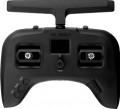Screen size
Display diagonal size in inches. The larger the display, the more accurate and easier to read the information displayed on it, the better the video stream can be seen on the screen in real time. On the other hand, a display that is too large entails an increase in the size and cost of the controller. In remote controls with the ability to display only service parameters, the screen size is usually from 1 to 3 inches, in copies with full color matrices and support for broadcasting a video stream - about 5 - 7 inches diagonally.
Radio frequency
The frequency at which communication takes place between the controller and the RU model.
In cars and radio-controlled special equipment, the most widely used analog standards are 27, 35, 40, 49 and 75 MHz. The base frequency is considered to be 27 MHz, and other options are used as an alternative to it, which ensures that signals from different remote controls are not mixed when located in the coverage area of several transmitters.
The
915 MHz frequency (or 868 MHz for certain regions) is often used in controllers to control drones using the ELRS protocol (see “Communication Protocol”). It provides increased range but requires large antennas.
Digital data transmission for controlling RC models and quadcopters can be performed at frequencies of
2.4 GHz,
5.1 GHz,
5.8 GHz. A significant advantage of these options is the channel separation technology, thanks to which the remote controls can operate in close proximity to each other without creating problems. The gigahertz bands differ in their communication range and throughput. Note that theoretically the 2.4 GHz frequency may be more susceptible to interference, because Many modern Wi-Fi modules work on it. However, thanks to the aforementioned channel distribution, such problems rarely arise.
Transmitter power
Rated power of the transmitter installed in the controller. This is an important parameter for ensuring reliable control of the RC model at a distance. The power of the transmitter is measured in milliwatts (mW), and the higher the number, the further the signal reaches and the more reliable control will be over long distances or in conditions of interference. In professional models of remote controls, the transmitter power can exceed 1000 mW (1 W).
External transmitter support
The option to connect an
external transmitter to the controller via micro or nano connectors allows for expanded functionality in managing RC models by supporting various communication protocols (see the relevant paragraph). For example, the default remote control operates on the TBS Crossfire protocol, while using an external transmitter allows for operation on the ELRS protocol.
Built-in memory
The amount of
built-in memory on board the controller.
Advanced devices are equipped with a data storage device - it is used to store firmware and record video streams from the RU-model camera. The larger the storage capacity, the more filmed videos can be stored in the controller’s memory. On the other hand, this characteristic directly affects the price. It is also worth considering that some remote controls allow you to supplement the built-in storage with a memory card (for more details, see “Card Reader”).
Card reader
The presence of
a card reader in the controller is a device for reading removable memory cards.
A card reader allows you to expand the standard memory capacity of your own drive, and in its absence, it will serve as the only option for storing data. At the same time, removable cards have a number of advantages: they are noticeably cheaper than built-in storage (in terms of per gigabyte of volume), and the capacity of such a card can be chosen at your discretion. Since card readers are available in many modern devices (laptops, smartphones, tablets, etc.), replaceable cards make it easier to exchange information with such devices.

